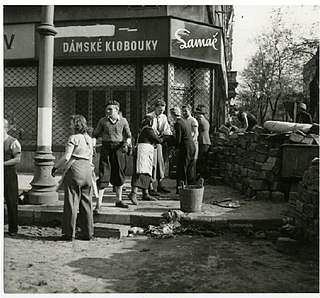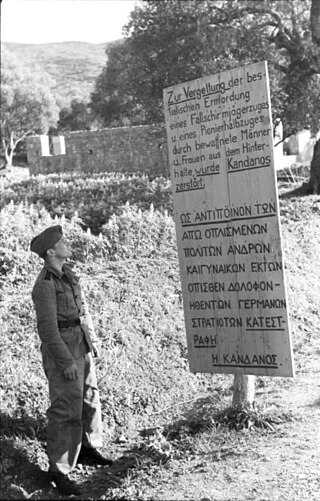Related Research Articles

The Lidice massacre was the complete destruction of the village of Lidice in the Protectorate of Bohemia and Moravia, which is now a part of the Czech Republic, in June 1942 on orders from Nazi leader Adolf Hitler and acting Reichsprotektor Kurt Daluege, successor to Reinhard Heydrich. It has gained historical attention as one of the most documented instances of German war crimes during the Second World War, particularly given the deliberate killing of children.

Reinhard Heydrich, the commander of the German Reich Security Main Office (RSHA), the acting governor of the Protectorate of Bohemia and Moravia and a principal architect of the Holocaust, was assassinated during the Second World War in a coordinated operation by the Czechoslovak resistance. The assassination attempt, code-named Operation Anthropoid, was carried out by resistance operatives Jozef Gabčík and Jan Kubiš on 27 May 1942. Heydrich was wounded in the attack and died of his injuries on 4 June.

The Prague uprising was a partially successful attempt by the Czech resistance movement to liberate the city of Prague from German occupation in May 1945, during the end of World War II. The preceding six years of occupation had fuelled anti-German sentiment and the rapid advance of Allied forces from the Red Army and the United States Army offered the resistance a chance of success.
Khatyn was a village of 26 houses and 157 inhabitants in Belarus, in Lahoysk Raion, Minsk Region, 50 km away from Minsk. On 22 March 1943, almost the entire population of the village was massacred by the Schutzmannschaft Battalion 118 in retaliation for an attack on German troops by Soviet partisans.

The governments of the German Empire and Nazi Germany ordered, organized, and condoned a substantial number of war crimes, first in the Herero and Namaqua genocide and then in the First and Second World Wars. The most notable of these is the Holocaust, in which millions of European Jewish, Polish, and Romani people were systematically abused, deported, and murdered. Millions of civilians and prisoners of war also died as a result of German abuses, mistreatment, and deliberate starvation policies in those two conflicts. Much of the evidence was deliberately destroyed by the perpetrators, such as in Sonderaktion 1005, in an attempt to conceal their crimes.
The Novye Aldi massacre was the mass murder of Chechen civilians on February 5, 2000, in which Russian forces went on a cleansing operation (zachistka), summarily executing dozens. The village had been cluster-bombed a day prior to the massacre, and local residents urged to come out for inspection the next day. Upon entering the village, Russian forces shot their victims with automatic fire at close range. The killings were accompanied by looting, rape, arson and robbery. As a result of the deadly rampage by Russian forces, up to 82 civilians were killed in the spree. Houses of civilians were burnt in an attempt to destroy evidence of summary executions and other crimes. Looting took place on a large scale and organised manner.

The Przyszowice massacre was a massacre perpetrated by the Red Army against civilian inhabitants of the Polish village of Przyszowice in Upper Silesia during the period January 26 to January 28, 1945. Sources vary on the number of victims, which range from 54 to over 60 – and possibly as many as 69. The Institute of National Remembrance, a Polish organization that carried out research into these events, has declared that the Przyszowice massacre was a crime against humanity.

The Huta Pieniacka massacre was a mass murder of the Polish inhabitants of the village Huta Pieniacka, located in modern-day Ukraine, which took place on February 28, 1944. Estimates of the number of victims range from 500 to 600-800 to 1,200.
The United States Armed Forces and its members have violated the law of war after the signing of the Hague Conventions of 1899 and 1907 and the signing of the Geneva Conventions. The United States prosecutes offenders through the War Crimes Act of 1996 as well as through articles in the Uniform Code of Military Justice. The United States signed the 1999 Rome Statute but it never ratified the treaty, taking the position that the International Criminal Court (ICC) lacks fundamental checks and balances. The American Service-Members' Protection Act of 2002 further limited US involvement with the ICC. The ICC reserves the right of states to prosecute war crimes, and the ICC can only proceed with prosecution of crimes when states do not have willingness or effective and reliable processes to investigate for themselves. The United States says that it has investigated many of the accusations alleged by the ICC prosecutors as having occurred in Afghanistan, and thus does not accept ICC jurisdiction over its nationals.

The Razing of Kandanos refers to the complete destruction of the village of Kandanos in Western Crete (Greece) and the killing of about 180 of its inhabitants on 3 June 1941 by German occupying forces during World War II.
The Čemerno massacre refers to the massacre of ethnic Serbs of the village of Čemerno, Ilijaš, in the Ilijaš Municipality, near Sarajevo, on 10 June 1992, during the Bosnian War.

The Częstochowa massacre, also known as the Bloody Monday, was committed by the German Wehrmacht forces beginning on the 4th day of World War II in the Polish city of Częstochowa, between 4 and 6 September 1939. The shootings, beatings and plunder continued for three days in more than a dozen separate locations around the city. Approximately 1,140 Polish civilians, were murdered.
The massacres in Piaśnica were a series of mass murders carried out by Nazi Germany during World War II, between the fall of 1939 and spring of 1940 in Piaśnica Wielka in the Darzlubska Wilderness near Wejherowo. The exact number of people murdered is unknown, but estimates range between 12,000 and 14,000 victims. Most of them were Polish intellectuals from Gdańsk Pomerania, but Poles, Kashubians, Jews, Czechs and German inmates from mental hospitals from the General Government and the Third Reich were also murdered. After the Stutthof concentration camp, Piaśnica was the largest site of killings of Polish civilians in Pomerania by the Germans, and for this reason, is sometimes referred to as the "second" or "Pomeranian" Katyn. It was the first large-scale Nazi atrocity in occupied Poland.
The Ascq massacre was a massacre of 86 men on 1 April 1944 in Ascq, France, by the Waffen-SS during the Second World War.
Walter Hauck was a German SS officer infamous for the atrocities committed under his command during the Second World War.

The Kandahar massacre, also called the Panjwai massacre, was a mass murder that occurred in the early hours of 11 March 2012, when United States Army Staff Sergeant Robert Bales murdered 16 Afghan civilians and wounded six others in the Panjwayi District of Kandahar Province, Afghanistan. Nine of his victims were children, and 11 of the dead were from the same family. Some of the corpses were partially burned. Bales was taken into custody later that morning when he told authorities, "I did it".
World War II saw the largest scale of war crimes and crimes against humanity ever committed in an armed conflict, mostly against civilians and specific groups and POWs. The war also saw the indiscriminate mass rape of captured women, carpet bombing of civilian targets and use of starvation as weapon of war.

The Arnsberg Forest massacre was a series of mass extrajudicial killings of 208 forced labourers and POWs (Ostarbeiter), mainly of Russian and Polish descent, by Nazi troops under the command of Hans Kammler from 20 to 23 March 1945.

The Bucha massacre was the mass murder of Ukrainian civilians and prisoners of war by the Russian Armed Forces during the fight for and occupation of the city of Bucha as part of the Russian invasion of Ukraine. Photographic and video evidence of the massacre emerged on 1 April 2022 after Russian forces withdrew from the city.
References
- 1 2 "Czech police investigate "forgotten" atrocities by Nazis from final days of WW II". Radio Prague International. 2005-11-03. Archived from the original on 2021-12-26. Retrieved 2021-12-26.
- ↑ "Leskovické tragédie" (in Czech). 9 May 2007. Archived from the original on 11 May 2014.
- ↑ "Nachrichten". Radio Prague (in German). 3 November 2005. Archived from the original on 2 January 2014.
- ↑ "La police tchèque sur la piste de trois anciens criminels nazis". Radio Prague International (in French). 2005-11-07. Archived from the original on 2021-12-26. Retrieved 2021-12-26.
- ↑ "Češi našli další tři nacistické zločince". iDNES.cz (in Czech). 2005-11-03. Archived from the original on 2021-12-26. Retrieved 2021-12-26.
- ↑ "Breakthrough in the investigation of WWII massacre in Velke Mezirici". Radio Prague International. 2006-03-13. Archived from the original on 2021-12-26. Retrieved 2021-12-26.
49°25′49″N15°4′49″E / 49.43028°N 15.08028°E